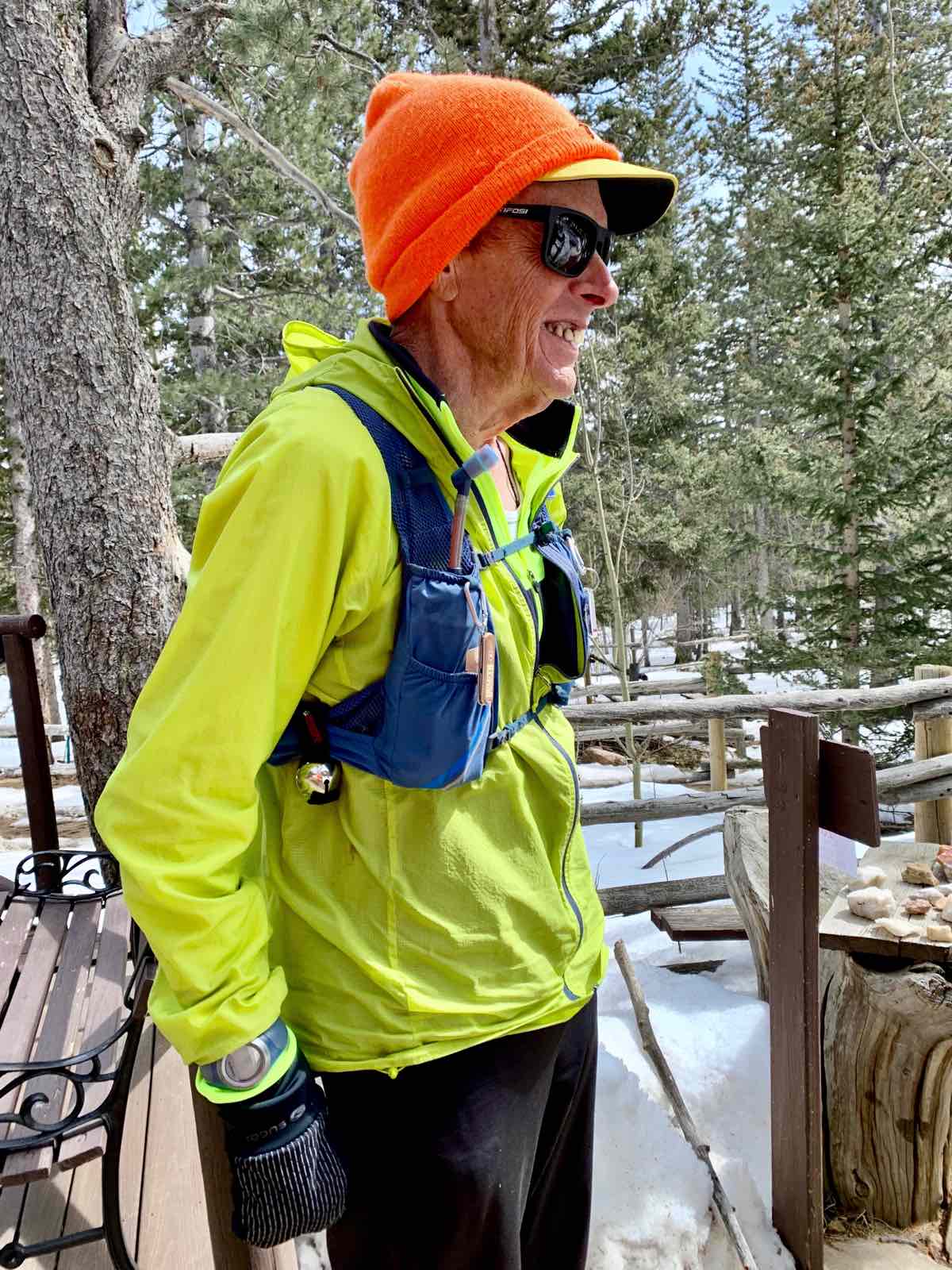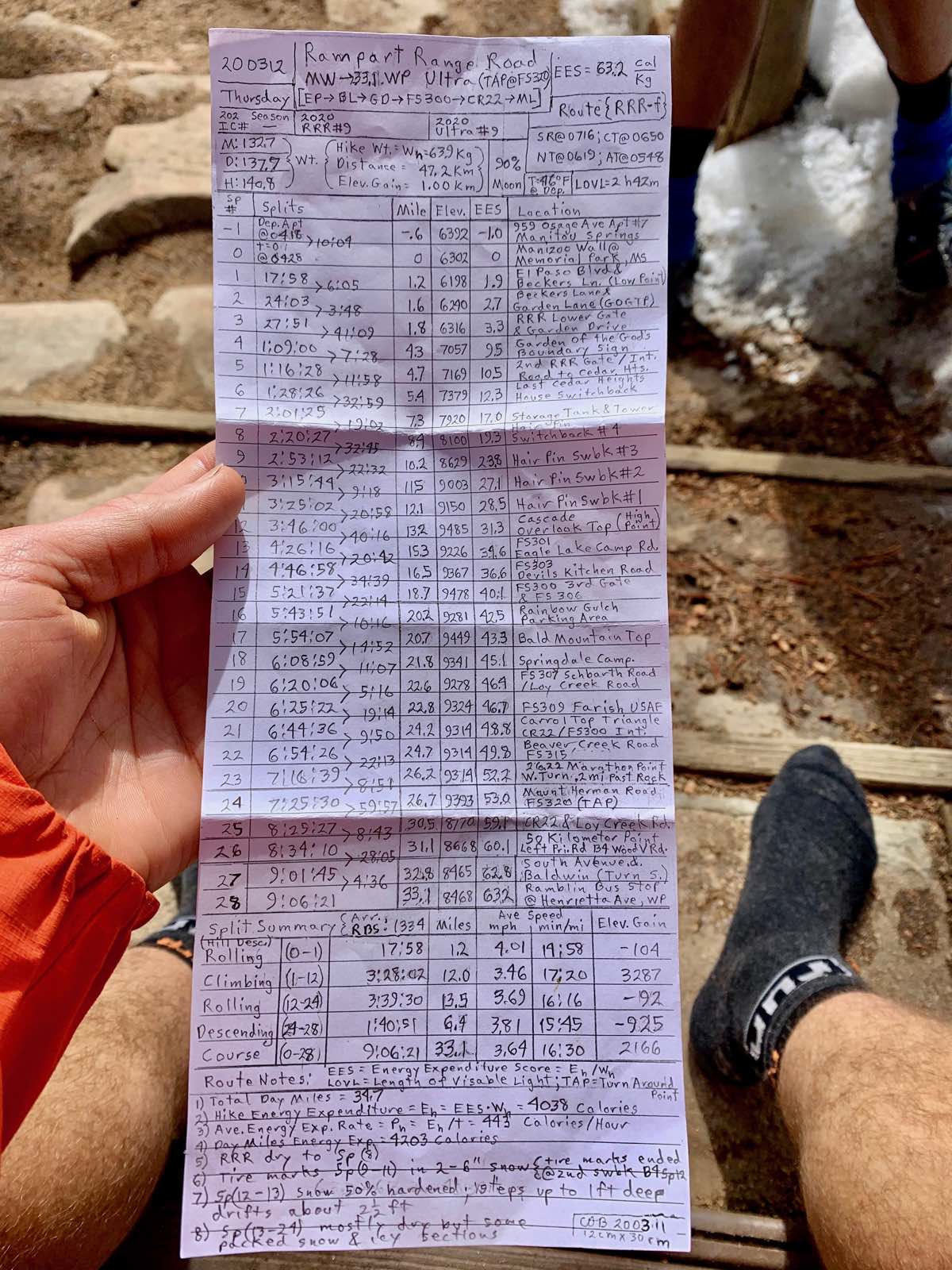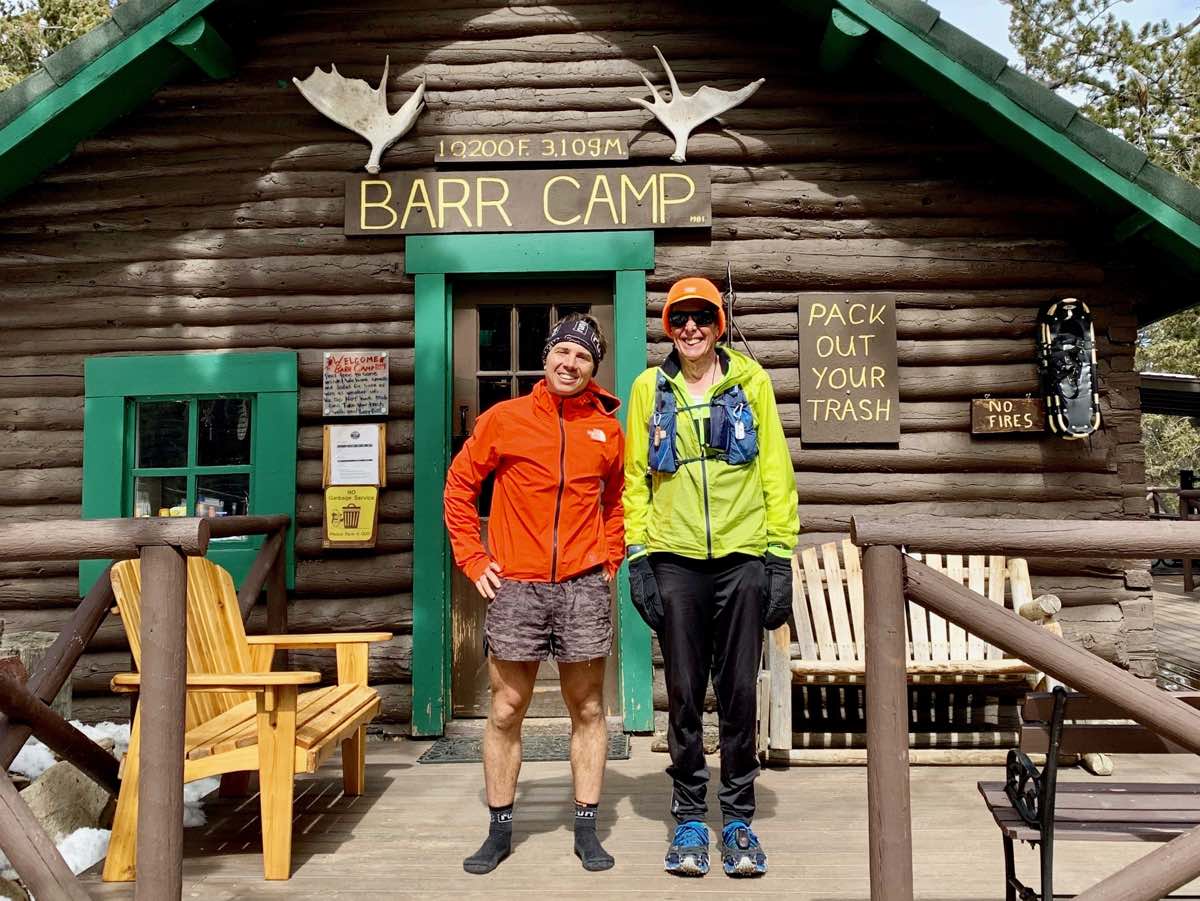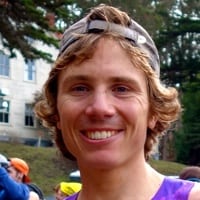It’s Sunday, and the door of Barr Camp on the side of Pikes Peak in Colorado flies open. A man bursts across the threshold and immediately starts talking. I know who it is in about two seconds. Heck, I barely need to hear the voice. The way he opens the door and the sound of his footsteps is enough. “The Cogs Rampart, baby! The Cogs Rampart is in great shape! And, I tell you what, I set a new PR! A new P-R, baby! Uh-huh, uh-huh, uh-huh.” I instinctively reach for a mug because I know he’ll want hot chocolate. I make it a big one. I give him the cocoa and he hands over his little backpack. I fill it with trash to hike out in exchange for the hot drink.
Some days trash is scarce and I have to scrounge around the cabin for something that ‘needs’ to go back down to town. Shoes, hats, left-behind clothes, nearly anything will do. I just need something to justify the exchange. Money isn’t an issue here, but this is our thing. I give him hot chocolate, and he hikes out trash and tells stories from the trail. This, my friends, is Craig.
Craig Dale Burbank was born September 30, 1953 in Englewood, California. Though California was his birthplace, Craig was raised in Arkansas. Then, in 1974 he returned to California to serve in the Navy. Craig stayed in the Navy until 1979 and worked as a machinist mate/engine-room operator. After his time in the Navy, he took a civilian job working as a coating technician. He lived in Auburn, in the foothills of the Sierra Nevada, and would commute to his job in a little Geo Metro. In August of 1993, Craig sold his car and started commuting to work on foot. That was the last time he owned a car. I guess you could say this is when ‘Craig the Walker’ was born.
The commute to work was about 4.5 miles. Initially it took him about 90 minutes, but he figured that was too long, so he learned to speed walk. If memory serves him correctly, he got the commute down to less than an hour. Eventually Craig left California and returned to Arkansas to be near family. He stayed in Arkansas for a bit, then moved to Texas, and finally, Colorado. He liked Colorado, as he was drawn to the mountains, and lived there from 1998 to 2008. Despite his fondness of the state, Craig returned to Arkansas in 2008 to be close to his ailing mother. During this time, he worked at Walmart. He stayed in Arkansas until 2014, but when his mother passed away he transferred to the Walmart in Woodland Park, Colorado and returned to the mountains.
If Auburn was the birthplace of ‘Craig the Walker,’ then Woodland Park was the birthplace of ‘Craig the Ultra Walker,’ for it is here that he says he developed an interest in training for ultramarathon-distance walks. In Woodland Park, Craig spent his nights working as an overnight stocker at Walmart. In his free time, he would summit Pikes Peak. Most residents of Woodland Park would likely drive to one of the local trailheads and summit via the Barr Trail on the east side or the Crags Trail on the west. Not Craig. Craig would summit right from his front door. Leaving early in the morning (read: the middle of the night), Craig would walk nine miles from his home at mile marker 286 on Highway 24 to the base of Longs Ranch Road. He would then take Longs Ranch Road, to Bob’s Road, to Barr Trail, and continue on all the way to the summit of Pikes Peak. In total the journey was 22 miles. It was these long summits that Craig says sparked his interest in ultra training.
Then, in 2017, Craig decided to give retirement a go, left Woodland Park, and moved down to Manitou Springs. The location seems fitting for him as he is within walking distance (not Craig walking distance, but normal-person walking distance) of the Manitou Incline, Longs Ranch Road, Rampart Range Road, and, of course, his beloved Barr Trail. Most likely Craig can tell you the exact mileage from his doorstep to the start of each of these treasured routes.
Should you ever find yourself roaming about Manitou Springs, Colorado, keep an eye out for Craig. Often in a reflective vest, he tends to stand out. Even without the vest, he’s an easy find. His stride is strong and purposeful. His arms pump like the pistons of a Chevy big block. His posture is slightly hunched, like he’s leaning fully into what he’s doing, which he is. If not on foot, the one other place you may find Craig is the bus. In a country of convenience, where people are wed to their cars and phones, Craig bucks the system. He walks and rides the bus. He owns a ‘dumb phone,’ one of those flip phones with giant numbers like your grandparents’. The thing has a camera, though. I know because he uses it to take pictures on his walks which he prints out (on actual paper) and brings to Barr Camp.
Here at Barr Camp, Craig fits right in. Yet, as much as he fits in, he also stands out. I can honestly say that there isn’t anyone else on the trail quite like Craig. For one, Craig probably walks more than any other hiker. In fact, he probably does more mileage than most runners.
Don’t believe me? Check the data. Not the Strava data, though. You won’t find Craig there. Nah, Craig is old school. His watch is an old Polar that he got in 2006 or 2007. It syncs to a foot pod that mounts on his shoe. A while back the pod broke, and Craig figured out that if he opened it up, he could use tiny tweezers to bridge the gap between two metal contacts, thereby restarting the device. It’s pretty amusing to watch him do it. To top it off he’s even figured out that he can store the tweezers inside the pod itself. As he prepares to leave Barr Camp, he opens the pod, takes out the tweezers, touches the appropriate contacts, and hits the trail. It’s all so Craig.
But the foot pod is just the beginning. Craig’s gear is a story in and of itself. When it’s cold he tends to wear long sweatpants, a cycling jersey with big pockets across the back, whatever warm layers he may need, possibly a windbreaker jacket, and a fluorescent-orange knit hat. On top of all that he wears a very minimal running vest, his ‘Zach pack’ as he calls it. In the pockets of the cycling jersey and the running vest, he carries his gear and snacks. Some of the stuff is quite normal while other items are uniquely Craig. There is a small pocketknife which he hangs from a carabiner that he attaches to the loop on one side of the vest. On the other side is a second carabiner with a small thermometer attached. Wrapped around the side of the vest is a bear bell and tucked away somewhere is his trash bag. In warmer whether the gear is more or less the same, just a bit lighter.
He’s got a system for tracking altitude. If he’s out for a short walk (short is a relative term), he carries an old Garmin GPS running watch–that’s in addition to the Polar watch and foot pod used. It tracks well but has a short battery life so on longer walks he carries an analog altimeter which he calibrates with the barometric pressure and his starting altitude. Tucked into the little elastic straps on the front of the pack are a set of small pocket maps rolled up like cigars.
Somewhere inside the pack are even more goodies. Perhaps the most important is a plastic bag filled with log sheets. They are incredible. Craig is the master of logging numbers by hand. Hang around him long enough and there is a pretty good chance he’ll whip one of his sheets out and show you his work. On them you will find all sorts of details. The most prominent thing on the sheets are splits. But, these aren’t just times. For each split, Craig logs time, distance, elevation, location, and his EES (Energy Expenditure Score).
The splits are taken at all sorts of random intervals, some less than half a mile apart. They come at places like the Manizoo Wall at Memorial Park; hair pin switchbacks one, two, three, and four; the Storage Tank; and the Tower. Craig’s sheets also include things like his weight (which he checks before each walk while wearing all of his gear), total distance, net elevation gain, moon phase, temperature, sunrise, nautical twilight, civil twilight, and astronomical twilight. There is a lot more, too.
To say that Craig is detail-oriented would be an understatement. Thank goodness he is, because the stats are astounding. In 1999 Craig did his first race, the Pikes Peak Ascent. The next year he did it again. Then in 2001 he did the infamous Pikes Peak double (the Pikes Peak Ascent on Saturday followed by the Pikes Peak Marathon on Sunday). In 2003 he had a banner year, setting a new PR in the Pikes Peak Marathon, and nabbing an ascent PR en route. His times? Three hours, 31 minutes, and 12 seconds on the way up and two hours and 43 minutes on the way down for a total time of six hours, 13 minutes, and 55 seconds. He walked every step.
And just like that Craig was done with the Pikes Peak Marathon. Sure, he did the Barr Trail Mountain Race from 2000 through 2006, and plans to do it again in 2020, but he is yet to return to the Pikes Peak Ascent and Marathon. Why? Superstition. In 2001, the year Craig did the double, he completed the Pikes Peak Marathon in six hours, 55 minutes, and 13 seconds. When he completed the marathon in 2003 in an eerily similar, but inversed time (6:13:55 versus 6:55:13), he didn’t know what to make of the similarity, so he never did it again.
In recent years, Craig has amassed some incredibly impressive training stats. In 2018 Craig set a goal of walking 5,000 miles. He surpassed it by 162 miles, logging 5,162 miles for the year. That’s an average of 99 miles per week, or 14 miles per day. (His weekly-mileage record is 168 miles.) And remember, that’s walking. Also interesting to note, Craig says that at this stage he was still in the infancy of his ultra training. Since then he has been experimenting with different training methods. Having studied coach Jason Koop’s training book, Craig now plays around with doing higher intensity and less mileage. He says he’s noticed an improvement, although he still thinks he could go for high volume.
For 2019, Craig set a new goal. He wanted to try to do one ultra per week. Though he fell a bit short, he still did 39 training ultras, including five 50-plus milers and nine 40-plus milers. The rest were somewhere between 26.2 and 30 miles. And his yearly mileage was 3,766 miles. Looking to this year and the future, Craig has some new goals in mind. For one, he would like to do one ultra per week. He admits that the winter weather has been challenging. He only got two ultras done in January, but he got one per week in February and says he is still on track for March. Aside from the ultras, Craig would also like to break is energy expenditure score PR of ninety-one. He figures he can do this by walking the entirety of Rampart Range Road, a 56-mile route starting from Memorial Park in Manitou Springs.
Additionally, he would like to focus a bit more on intensity. To do so he would like to incorporate things like the ‘double Incline.’ This isn’t simply two repetitions of the Manitou Incline (a popular route in Manitou Springs that gains roughly 2,000 vertical feet in a little less than a mile). A double incline for Craig is going up the Manitou Incline, continuing up Barr Trail, hanging a right on the Bottomless Pit Trail, cutting off of that, and making a beeline for the summit via the Northeast Ridge. Craig says that this second incline, or ‘Papa Bear Incline’ as he likes to call it, goes from around 10,900 feet to 14,115 feet in about 1.4 miles. Talk about a quad burner!
Looking to the future, Craig has thoughts of training for a 100-mile race. He expresses interest in the Leadville Trail 100 Mile, though he says he would like to walk 100 miles in training first. He even has a route in mind. He says he would like to do a road version of the Pikes Peak Ring the Peak route. He figures it will have an EES (energy expenditure score) a little lower than that of the Leadville 100. Are Craig’s methods typical? No. He is well aware that his ways are not necessarily the standard protocol, but this is the way he thinks he should proceed.
This is what makes Craig so great. He isn’t trying to be anyone he isn’t. He’s just being himself. He’s been without a car for 27 years. He rides the bus, walks to the grocery store, uses his same-old gear year after year, reads up on training, and then applies it as he desires. When it snows, he takes the honor of breaking trail and reaps the reward of the resistance training. He walks while the others run because it’s what he prefers to do. He gets jazzed when he PRs and keeps plugging away when he doesn’t. He records all the numbers, but doesn’t seem to let them control him. Above all, he’s so happy and passionate about what he does. When he talks of his accomplishments, he beams with pride in a joyful and content sort of way.
In short, I think we could all learn to be a bit more like Craig: invested, enthusiastic, curious, and true. Because at the end of the day the only person Craig is, is himself, and that’s what makes him so great. That’s what makes him Craig the Walker.
Call for Comments (from Meghan)
Do you have a story about Craig the Walker? Leave it in a comment. Thank you!



